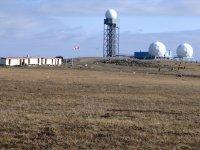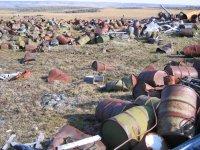CAM-D (Simpson Lake) Remediation Project
CAM-D is located in the middle of Boothia Peninsula, approximately 80 kilometres west of Kugaaruk and 120 kilometres east of Gjoa Haven.
On this page
Contaminant of Concern
The primary concern at CAM-D is Polychlorinated Biphenyls (PCB) materials. The PCBs are in the building paints, the buildings and site litter. The soil is also contaminated with hydrocarbons and heavy metals.
History of Site

CAM-D is a former Distant Early Warning (DEW) Line Site constructed in 1957 and then closed and abandoned in 1963. In 1977, the site was converted to a scientific research station. Throughout the 1980's and 1990's there were site assessments and work done to address the contaminants at the site. The site was identified as a priority site for clean-up under the Federal Contaminated Sites Accelerated Action Plan in 2003.
Environmental assessment of the CAM-D DEW Line Site was initiated in 1985 when the Department of National Defence and Environment Canada visited the site to remove contaminants such as PCBs and POLs and identify areas of buried materials that could pose environmental risks in the future. Various pieces of PCB-containing equipment were removed from electrical cabinets at the site. Soil samples collected from beneath the cabinets identified PCB contamination. No other results were reported.
The site was revisited in 1994 by the Environmental Sciences Group of Royal Roads Military College at which time a surface soil sampling program was completed. Their investigations identified soil contamination near the module train outfall, the garage, the main dump and at the debris area near Simpson Lake. However, these investigations did not include assessment of hydrocarbon contamination that has the potential to be a significant source of contamination at the site.
Current Activity

In August 2005, Indian and Northern Affairs Canada (INAC) completed the last phase of the site assessment program. Work included a review of all previous assessment and cleanup activities, field investigations, development of engineering plans, and regulatory approvals.
Volumes of contaminated soil, hazardous and non-hazardous materials at the site have been quantified. Suitable locations for engineered landfills or soil treatment facilities, and potential aggregate borrow sources have been identified. Cleanup options for the site are currently being developed and will be discussed with stakeholders.
INAC will keep residents informed of the latest cleanup plans and will seek their input on any concerns they may have. Plans to hold community consultation meetings in Gjoa Haven, Kugaaruk and Taloyoak are already underway.
The development of a final detailed work plan, additional consultations, regulatory approvals and issuance of contracts are anticipated in 2006. Cleanup and subsequent consultations will follow.
Economic Benefits
During the 2005 field program, use of the community facilities and services, and employment opportunities provided some benefit to the community.
INAC will continue providing opportunities for Nunavummiut through the contractors' selection process.